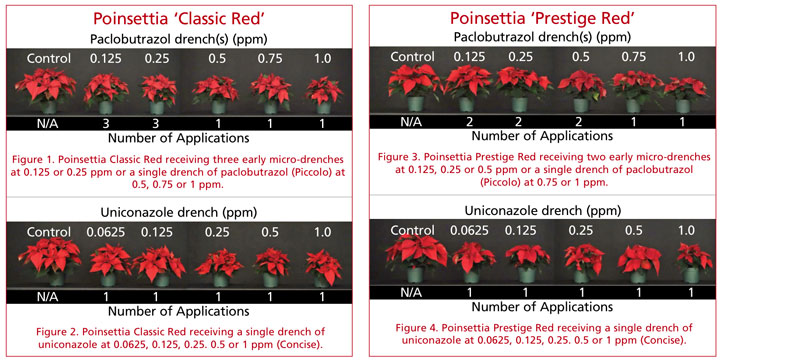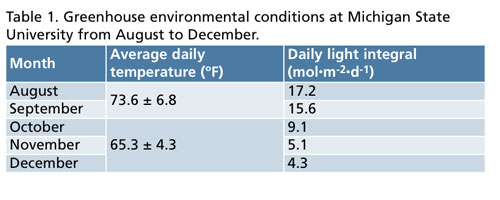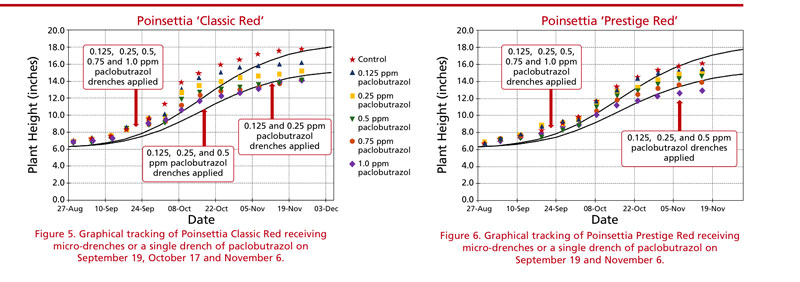5/1/2021
What’s All the Hype on Poinsettia Micro-drenches?
Roberto Lopez
Height control can be one of the most challenging aspects of production for greenhouse growers. Undoubtedly, the number one challenge is the unpredictability of the weather, as it can cause year-to-year environmental variability in temperature and light levels even within the greenhouse. On top of this, there are numerous cultivar introductions, container sizes dictated by retailers and changing market dates that you must deal with every year. Therefore, growers must continuously adjust their height management strategies and tools to ensure that they meet the specified height requirements and market dates.
Luckily, greenhouse growers have many plant growth retardants (PGRs) that can be applied as either a foliar spray or substrate drench available in their toolbox for use on poinsettias. A drench is the application of a specified volume of PGR solution to the growing substrate, so the active ingredient is primarily absorbed by the roots. It then moves from the roots to the shoot tips, where it acts to inhibit the biosynthesis of gibberellins, the plant hormone that’s responsible for extension growth.
PGRs with the active ingredient paclobutrazol (Bonzi, Downsize, Pac O, Piccolo or Piccolo 10XC), uniconazole (Concise and Sumagic), flurprimidol (Topflor), ancymidol (Abide and A-Rest), and chlormequat chloride (Citadel and Cycocel) are labeled for use on greenhouse crops as a drench. However, some of these PGRs require large amounts to be effective or are cost prohibitive. And while ethephon (Florel and Collate) is effective, it’s not registered for use as a substrate drench.
The nice thing about poinsettia drenches is they can be applied throughout the growing season, can have less of a negative impact on bract size compared to foliar PGR sprays and have a longer period of activity than sprays. PGR drenches have traditionally been applied late in production to stop the crop once it’s reached a desirable height. However, a late drench has the potential to reduce the size of developing bracts.
A relatively newer technique to inhibit extension growth of aggressive poinsettia cultivars is to apply early, low-dose PGR micro-drenches. Micro-drenches are generally 1/8 to 1/10 of the traditional rates used for drenches and sprays. Based on previous research utilizing Topflor on poinsettia, micro-drenches can lead to toned and uniform plants throughout production. This ultimately requires less total PGRs than one heavy or stop drench application, and leaves more room for error.
In this article, we compare the efficacy of early paclobutrazol (Piccolo) or uniconazole (Concise) low dose micro-drenches to a single heavy drench with graphical tracking on two popular red poinsettia cultivars under northern U.S. growing conditions.

Research methodology
On Week 32 (August 7), Classic Red and Prestige poinsettia rooted cuttings were received at Michigan State University (MSU) from a commercial propagator. The following day, they were transplanted into 6.5-in. containers filled with a peat, perlite and vermiculite substrate. Plants were pinched to the sixth node soon after roots reached the container edges on Week 35. They were placed under a 16-hour photoperiod consisting of natural daylengths with day extension lighting provided by high-pressure sodium lamps until the start of short days (SD). The day and night air temperatures set points were 75/67F (24/19.5C) and on October 1, the day/night air temperatures were lowered to 71/65F (22/18.5C).
On Week 40 (October 1), black cloth was manually pulled from 5:00 p.m. to 8:00 a.m. to create a nine-hour SD. All plants were spaced on 14-in. centers. Each week, the height of the same five plants in each treatment were measured from the base of the container and to the highest point of the plant by the same individual. The height measurements were entered into graphical tracking software and PGR drench application(s) were made based on these measurements.
On Week 38 (September 19), 0, 0.125, 0.25, 0.5, 0.75 or 1.0 ppm paclobutrazol (Piccolo) or 0.0625, 0.125, 0.25, 0.5 or 1.0 ppm uniconazole (Concise) were applied to both cultivars at a volume of 4 fl. oz. per 6.5-in. container to ensure the PGRs were well distributed and retained entirely within the container. A second drench of 0.125, 0.25 or 0.5 ppm paclobutrazol was made to Classic Red on Week 42 (October 17), a second drench of 0.125, 0.25 and 0.5 ppm paclobutrazol was made to Prestige, and a third application of 0.125 or 0.25 ppm paclobutrazol was made to Classic Red on Week 45 (November 6). Due to the stronger efficacy of uniconazole, no other applications were made.
Research findings
Generally, three micro-drench applications of paclobutrazol at either 0.125 or 0.25 ppm were effective at controlling height of Prestige and Classic Red within our range of 15 to 17 in. (Figures 1, 3, 5 and 6). Classic Red receiving a single micro-drench of uniconazole at 0.0625 ppm was just above the minimum height requirement of 14 in. for some growers (Figure 2). While Prestige, receiving 0.0625 and 0.125 ppm uniconazole, were above the 14 in. minimum height requirement (Figure 4).
Time to marketability was either not delayed or delayed by up to three days for Classic Red receiving micro-drenches of uniconazole or paclobutrazol, respectively. For Prestige, a single drench of uniconazole at 0.5 or 1 ppm delayed time to marketability by five days. Regardless of the paclobutrazol or uniconazole micro-drench or drench rate, bract area was reduced by >30% for Classic Red and >16% for Prestige.
Even though paclobutrazol and uniconazole micro-drenches reduced overall bract area, there was no reduction in the crop ornamental appearance. Generally, for both Classic Red and Prestige, there were no to only slight differences in bract area:height ratios between untreated and plants treated with micro-drenches. However, one drench at a higher rate significantly reduced the bract area:height ratio. This demonstrates that while bract area is reduced with early paclobutrazol and uniconazole micro-drenches, the reduction in bract area and plant height are proportional to each other and doesn’t negatively impact the aesthetic appearance of the finished plants (Figures 1, 2, 3 and 4).
Commercial application
For vigorous poinsettia cultivars grown in the northern United States, growers can apply multiple early micro-drenches of paclobutrazol or a single early drench of uniconazole at a lower rate. Additional late-season PGR applications can be made based on crop needs. For less-vigorous cultivars grown in the north, a single micro-drench can be applied for cultivars that usually need some type of height control. Growers in the south will likely need higher concentrations for adequate height control.
As with any new PGR application method, we recommend you conduct small trials with micro-drenches before implementing on a large scale. Effective rates were determined under a relatively warm and partly cloudy fall (Table 1).
Poinsettia micro-drench guidelines
• Do not utilize drenches on slow-growing cultivars.
• Apply after pinch and utilize graphical tracking to determine if a PGR application is needed.
• Do not be overly reactive if plants are above the curve.
• Increase rates by up to 25% if your substrate contains bark.
• Water the crop the day before the drench, so that the PGR is absorbed evenly.
• Apply to drenches to moist (but not excessively dry or wet) substrate.
• Ensure that each container is receiving a uniform amount of PGR solution.
• PGR drench volumes for various container sizes:
2.4 oz. for 4.5-in. azalea container
4.0 oz. for 6.5-in. azalea container
7.7 oz. for 8-in. azalea container
13.6 oz. for 10-in. basket (4.5 L)
15.6 oz. for 10-in. azalea container
19.7 oz. for 12-in. basket (6.5 L)

The author gratefully acknowledges Fine Americas, Inc. for chemicals and funding, the Western Michigan Greenhouse Association for funding, Dümmen Orange for plant material, The Blackmore Co. for fertilizer, East Jordan Plastics for containers, and Nathan DuRussel and Anthony Soster for greenhouse assistance and data collection.
Roberto Lopez is an Associate Professor and Controlled Environment/Floriculture Extension Specialist in the Department of Horticulture at Michigan State University.